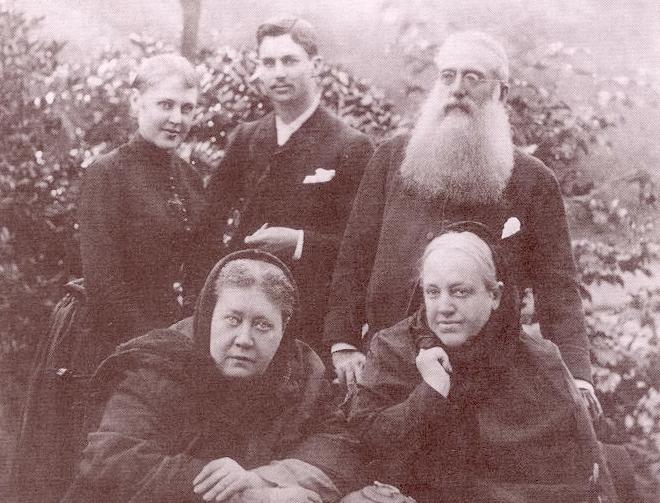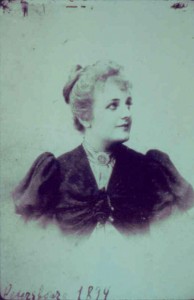
Clockwise from top left: Vera Johnston, Charles Johnston, Henry Olcott, Vera Zhelihovsky, and Helen Blavatsky
In the early 1900s, a woman named Vera Johnston was involved with the Russian cathedral in New York and the seminary in Tenafly, New Jersey. With a name like Johnston, you might think that she was a convert, which is exactly what I thought when I first ran across her name. But Vera Johnston was actually a cradle-born Orthodox Christian. She was born in the Russian Empire, in what is now Ukraine, and her maiden name was Zhelihovsky. She was born in 1864, and her mother was also named Vera.
Before her marriage, the elder Vera, the mother, was named Vera Blavatsky. That last name, Blavatsky, might sound familiar to some of you. The elder Vera’s sister – so, our Vera’s aunt – was a lady by the name of Helen Blavatsky – also known as Madame Blavatsky, the founder of the Theosophical movement.
Theosophy has been described by some as a modern version of Gnosticism. It has a lot of occult and pagan elements, drawing in particular on Hinduism. Helen Blavatsky herself spent time in India. Beliefs included reincarnation, ancient pagan deities, secret teachings. Essentially, we’re talking about neo-paganism. They certainly had a kind of syncretistic place for Christianity, as one of the many pieces of the “truth” that could lead you into true knowledge, but basically, this is a neo-pagan movement.
Helen Blavatsky had founded the Theosophical movement in the 1870s, and in 1886, her niece Vera – the future Vera Johnston – spent some time with her aunt, and read drafts of her book The Secret Doctrine. Vera was in her early twenties at this point, and her mother was a follower of Aunt Helen, so it was only a matter of time before young Vera herself became a Theosophist.
In 1889, Vera published an article called, “Modern Magic” in the Theosophist journal, and by this time she had apparently joined the movement. The year before this, in 1888, she had married Charles Johnston, an English follower of Blavatsky. Johnston himself was one of the leaders in the Theosophy movement, and was especially noted for his translations of Hindu scriptures from Sanskrit into English. Vera and Charles spent some time in India themselves, and both wrote and translated numerous Theosophical articles in the coming years. For example, in 1895, they coauthored an article called, “The Priestess of Isis and Her Accusers.” This was sort of par for the course with Vera and Charles.
Helen Blavatsky herself died in 1891, and in 1896, Charles and Vera Johnston moved to New York City. Vera was still a very visible figure on the Theosophical scene, speaking at conventions and translating articles.
Sometime after the turn of the century, the Johnstons became associated with the Russian Orthodox cathedral in New York. Now, the details on this are very sketchy. What I’m giving you is basically incomplete research. I just haven’t been able to find very many materials on Vera Johnston’s life after 1900 or so, and of course this period in which we’re most interested, because this is when she was associated with the Russian Mission.
So please understand, much of this is a mystery. But I’m going to give you what I have.
In 1912, the Russian Archdiocese moved its seminary to Tenafly, New Jersey. Both Vera and Charles Johnston were professors. I don’t know what subject Vera taught, but Charles is listed in 1918 as “Teacher of English Language.” During this period, Vera ran the seminary’s booth at a Russian bazaar in New York City (New York Times, 3/28/1915). Both Johnstons were deeply involved in the work of the Russian Mission.
Also in 1915, she wrote an article in the Constructive Quarterly called, “The Coming of Archbishop Evdokim,” talking about the arrival of the new Russian bishop. One passage in particular seems to reveal something of Vera’s own religous outlook:
In the principle thus simply and eloquently enunciated by Archbishop Evdokim, what vistas there are of reconciliation, of genuine peace and good-will among men and nations: the differences between nations, in their religious as well as their secular life, are not stumbling-blocks but revelations of the wisdom of God. The mind of Christ is so wide, so deep, so rich, that no one race, nothing less than all humanity, suffices to embody and reveal it. [Emphasis in original.]
The same year, also in the Constructive Quarterly, she translated an article called, “Byzantium the Preserver of Orthodoxy.”
So it seemed, when I learned these things, that Vera Johnston had converted – or, re-converted – to Orthodoxy. She was involved, almost on a day-to-day basis, with the life of the Russian Mission. The thing is, she doesn’t seem to have given up Theosophy. Her husband Charles, who was also involved in the Russian Mission, remained a major figure in the Theosophical movement.
In early 20th century New York, a splinter Theosphical group was formed, calling itself the “Order of the Living Christ.” While small, this group included some of the city’s elite — Wall Street executives, professors, Episcopal priests, etc. — as well as Charles and Vera Johnston, whose ties to Helen Blavatsky helped bring legitimacy to the Order. The Order was essentially an attempt to merge Christianity and Theosophy. The group believed in reincarnation, but adopted the externals of Anglo-Catholicism (traditional Anglicanism). They revered the works of Helen Blavatsky and her associates, but also had a deep fascination with early Christian mysticism. Members saw it as perfectly acceptable to be a part of the Order and still participate in the life of, for instance, the Episcopal Church. It is likely that Vera Johnston shared this philosophy, and she may well have considered herself an Orthodox Christian while simultaneously adhering to beliefs which Orthodoxy recognizes as patently heretical. All this, while teaching future priests at the official seminary of the Russian Archdiocese in America.
Vera Johnston died in 1923, just shy of 60. Charles passed away eight years later. It is likely that documents survive — perhaps the OCA archives — which can help us to better understand the Johnstons’ role in the Russian Mission, and the extent to which their Theosophical ideas were known by the Russian clergy who employed them. If any of our readers can shed more light on this odd episode in American Orthodox history, please let me know.
[This article was written by Matthew Namee. I am indebted to Jake Benson for his help in researching Vera and Charles Johnston.]

You might want to explore the Liberal Catholic Church and the Liberal Catholic Church International
Yeah, because evidently the Theosophists lingered on. At least according to a story told me by the Hieromonk Hillary of Holy Trinity Cathedral. Once, while he and HG + John Garklavs of Chicago were going through things, His Grace opened a box of ripped vestments and a miter which had been punched in, and asked Fr. Hillary if he could repair or do something with them, as they had been laying in a closet for decades. When asked what had happened to them, he told the following story.
Back when HG had first come to Chicago in the late 40’s, the ecclesisatical situation was rather fluid and confused. A delegation of some purported parisioners came to the home where the bishop was, identifed themselves as a parish, and asked the bishop for a visitation, to which he agreed.
He came to the parish, and was vested with due ceremony. He was about to proceed with the service when someone told him “No, Vladika, we have to bring in the prophetess first.”
“The what?”
So in the midst of the Church HG saw them process in with a woman wearing some robes indicating some office, and install her in a place of honor near the iconostasis.
So, Archb. John of blessed memory said, HG could only follow biblical precedent. He rent and ripped his vestments off, took his miter and punched it, threw them down in disgust and stormed out.
A few days later, a box came in the mail with the vestments folded in them, with the miter on top.
What exactly they believed, Fr. Hillary didn’t say, but he identified them as Theosophists.
No kidding? What a story!
Fr. Patrick Mythen, about whom I’ve written in the past, also had a connection to a Theosophist pseudo-Christian body in California prior to becoming Orthodox. This group apparently was a rival to the New York pseudo-Christian group that the Johnstons were involved with. Mythen doesn’t seem to have had deep ties to Theosophy, but it’s another connection.
Perhaps we shouldn’t be surprised, though — after all, Theosophy was founded by a women from the Russian Empire, who was quite likely born Orthodox.
Hmmm. I’ve not researched this at all, but there may be something about Orthodoxy that attracts people on the religiously exploratory fringes. Just think of former HOOM people and former drifting hippies we now have in Orthodoxy. I raise this NOT to detract from the legitimacy of such journeys but only to note a possible pattern, here.
I should clarify, I am aware of the HOOM to Christ the Savior Brotherhood. What I’ve not researched is Vera Johnston and Theosophy.